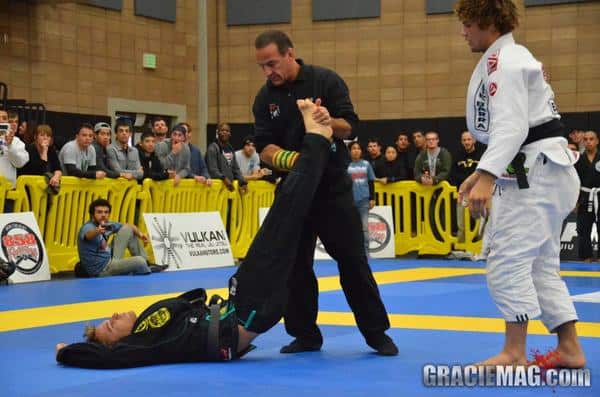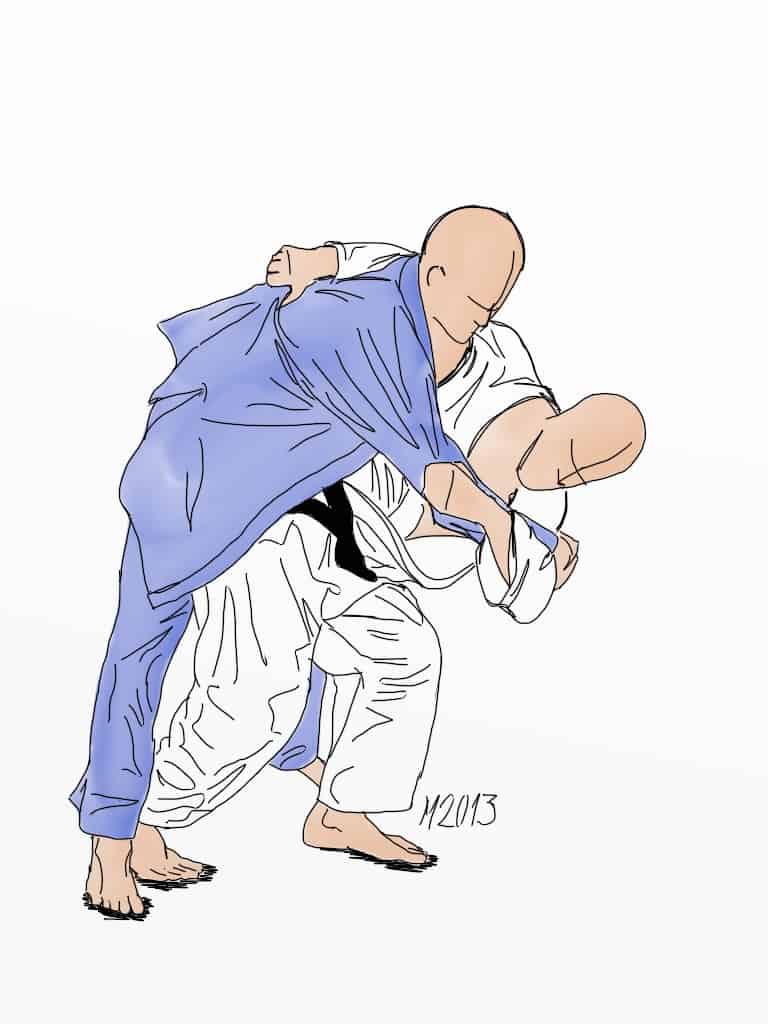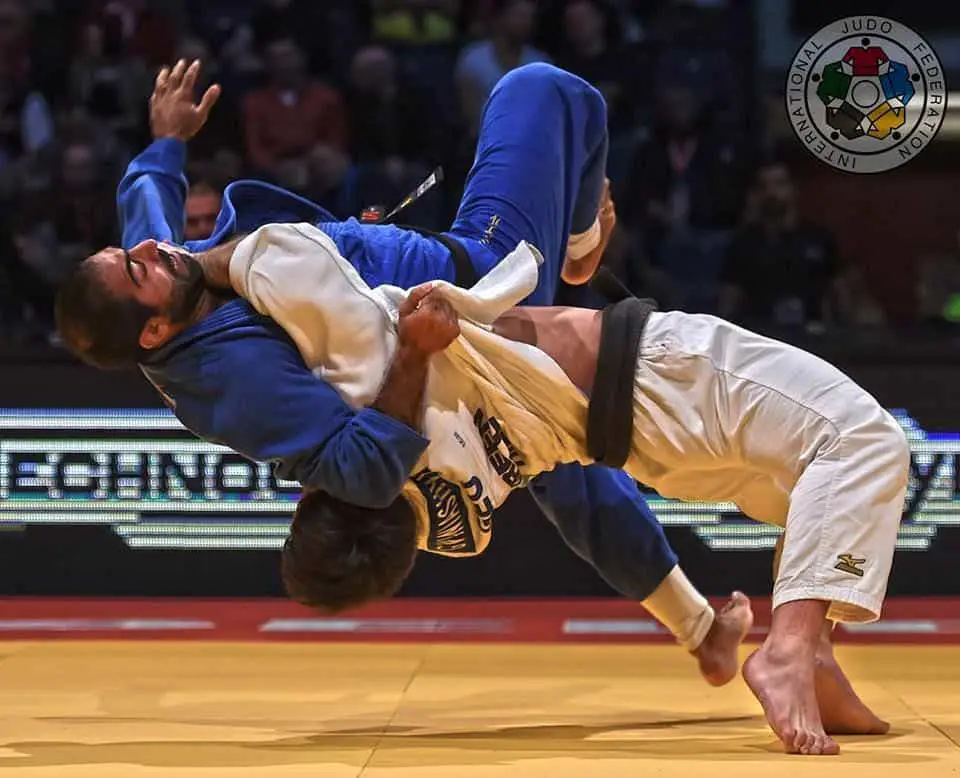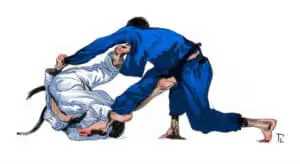You are preparing for your first comp and you want to know the rules to ensure you stay safe and don’t get disqualified. The rules in BJJ can often be confusing and ambiguous especially relating to takedowns and slams. Not to fear we will clarify all slam related queries throughout this article.
Can you slam in BJJ? No, in nearly all BJJ competitions including in IBJJF sanctioned events slams are illegal. You can not slam in BJJ due to the risk of injury to an athlete’s neck and head. BJJ emphasises controlling and submitting an opponent on the ground without hurting your opponent not on high amplitude slams. Slams in BJJ will result in an instant disqualification.

What Is Considered A Slam In BJJ?
A slam in BJJ is defined as picking your opponent up off the mat and then returning them to the mat with force or dropping them. If you do pick up your opponent you must stay connected to your opponent and return them slowly and safely back to the mat. This rule also applies if you opponent jumps onto you from the standing position. A takedown can also be considered a slam if you throw your opponent on their head or mid takedown you pause and then with force return your opponent to the mat.
A takedown where you lift your opponent off their feet and in one motion return them to the mat in a safe position should not constitute a slam however it is at the discretion of the referee and aggressive double legs have caused DQs in the past. To avoid the chance of DQ you should not lift during your double leg or single leg takedowns.
Interestingly Judo throws which are often high amplitude will almost never result in a DQ, exposing the inconsistencies in the BJJ slam rule. So feel free to score some air miles with your trusty Uchi mata or Harai goshi.
Why Are Slams Illegal In BJJ?

Slams are illegal in BJJ because they are dangerous. The goal of making slams illegal is to reduce injuries, particularly catastrophic injuries to athletes’ heads and necks. Slams in BJJ can result in concussions, spinal injuries and athletes being knocked out. Slams are not a key component of BJJ, therefore many BJJ athletes do not practice executing them and learning how to fall safely. This makes slams even more dangerous in BJJ.
How To Avoid Being Slammed In BJJ?
There a number of strategies you can use to avoid being slammed in BJJ.
In the standing position if your opponent has taken your back and he is preparing to launch you in the air with a suplex you can prevent this by taking your leg and hooking it behind your opponent’s opposite leg. This is known as grapevining and will prevent your opponent from being able to lift you.
Another strategy you can use to avoid being slammed is performing a diving granby roll from the standing position. To perform this technique you will starting moving in a diagonal direction and do a forward roll over your inside shoulder. The force of the roll will make impossible for your opponent to hold onto their body lock.
When you are in guard there two things you can do to avoid being slammed. Firstly you can simply release the submission that you are holding onto. If you have an armbar or triangle locked up but you can’t control your opponent from standing up to avoid being slammed just release the submission.
The second option you have is to hook your opponents legs after you have locked up your armbar or triangle. By hooking your opponent’s leg they will not be able to stand up and you will be safe from being slammed.
Can You Suplex In BJJ?
In BJJ you can not perform a suplex which is defined as a back arching throw where your opponent lands on their neck or head. The rules concerning suplexes are not explicit and even if you throw your opponent safely on their back you may still be disqualified. Suplexes are not usually taught in BJJ and athletes are not accustomed to falling safely when being thrown. If you want to perform a suplex variation but don’t want to risk being disqualified you should perform a mat return where you pick your opponent up but return them to their side.
Why can’t you suplex in BJJ? You can’t suplex in BJJ because a suplex is a high risk move where there is potential for serious neck and head injures. A suplex takes years to learn how to perform and years to learn how to fall while being thrown. Suplexes are not trained or practiced frequently in BJJ and therefore BJJ athletes do not have the skills to perform them safely in competition.
Are Throws Allowed In BJJ?

Yes, nearly all Judo and wrestling throws are allowed in BJJ. A Judo throw no matter the amplitude will be allowed in BJJ. A Judo throw will only lead to disqualification in BJJ if an athlete intentionally throws their opponent on their head. This can happen in Judo throws such as dropping Ippon seoi nage. Most wrestling throws are allowed in BJJ with exception of high amplitude back arching throws which will most likely lead to disqualification even if you perform the throw in one motion and your opponent lands safely on their back.
There are two judo throws which are not allowed to be performed in BJJ. Ura nage which is a back arching suplex and Hikikomi gaeshi which is where when defending a head on the outside single leg the defender will grab his opponent’s belt and slam his opponent downwards towards the mat face first. The prevalence of this move in BJJ actually resulted in the IBJJF banning head on the outside single legs.
Most wrestling throws are allowed in BJJ as long as they occur in one continuous motion and your opponent is returned to the mat in a safe manner. Wrestling throws where an athlete is lifted in the air, then a pause occurs before the athlete is returned forcibly to the mat is not allowed.
Back arching throws are also not allowed even if they occur in one motion, you may get away with a back arching throw if your opponent lands safely on their back but you will be intermediately disqualified if any of your opponent’s neck or head makes contact with the mat.
Are Hip Throws Legal In BJJ?

Yes, hip throws are legal in BJJ. A hip throw which is performed in one motion where the athlete is returned safely to the mat is legal in BJJ. A hip throw is only illegal if the throw results in an athlete landing on his neck or head or if there is a pause during the throw while the athlete being thrown is suspended in the air. These two infractions are illegal and will result in a disqualification.
Hip throws are very popular in BJJ training and competitions. O goshi, Harai goshi and Uchi mata are used extensively in BJJ. Hip throws are an effective form of takedown in BJJ. Athletes just need to be aware of forward rotation when throwing their opponents as this can result in their opponents rolling through the throw and taking their back.
Can You Slam At ADCC?
Yes, you can slam at ADCC but only if you are caught in a submission attempt and you are using the slam to avoid being submitted. You can not pick up your opponent off the ground and slam them if they are not attempting a submission. You also can not intentionally slam an opponent on their head or neck when executing a takedown.
ADCC is not a BJJ tournament. ADCC was created by Sheikh Tahnoun in 1998 as a mixed grappling event to see which style of grappling was most effective. The rules of ADCC were designed to give all grappling styles a fair chance of proving their superiority. This is why slams are allowed in ADCC to allow wrestlers and Judokas the ability to showcase their techniques. Slams also force BJJ athletes to face the reality of what can happen if they attempt to apply a submission without maintaining control of their opponent.
Below is a great video which shows why slams keep BJJ athletes honest.
Are Slams Allowed In Judo?

Yes slams are allowed in Judo. The goal of Judo is to slam your opponent forcefully to their back. A slam in Judo where your opponent lands squarely on their back results in instant victory known as an Ippon. Slams which “may endanger or injure the opponent especially the opponent’s neck or spinal vertebrae” are illegal but as long as you slam your opponent on their back they are allowed and encouraged.
Slams are allowed in Judo because Judo athletes spend a lot of time learning how to falling correctly and safely. Learning how to fall without suffering an injury is known an Ukemi or break falling and is a major part of Judo training. Many Judo gyms will not allow athletes to spar until they are competent in Ukemi. The emphasis Judo places on falling safely reduces the risk of slams resulting in injury.
BJJ does not have this same attitude to break falling. In BJJ gyms many athletes are allowed to spar on their first day and very limited training time is dedicated to learning how to fall. It is not uncommon to find BJJ purple belts who can not fall correctly and who would be injured in a wrestling or Judo tournament.
Slams are also legal in Judo because the founder of Judo, Kano specifically adapted and modified existing takedown techniques from Ju Jitsu to make them safe for training and competition. For every Judo throw Kano ensured there was a corresponding Ukemi technique.
Are You Allowed To Slam In Wrestling?

Yes, you are allowed to slam in Freestyle and Greco-Roman wrestling. Both of these styles of wrestling emphasise slams by awarding maximum points for successful slams. However you are not allowed to slam in folkstyle wrestling. Throws where your opponent’s feet go over their head for example suplexes are banned in folkstyle wrestling. Also if a wrestler returns his opponent to the mat after lifting him with too much force he will be penalised for a slam.
Similarly to Judo athletes, wrestlers particularly Greco-Roman wrestlers spend a lot of time training throws and being thrown. The risk of injury when being slammed is greatly reduced when both athletes know how to throw and be thrown. Injuries usually occur from poorly performed slams or when an athlete takes a bad fall due to poor break falling techniques. Slams are a key component of wrestling and because of that wrestlers become experts at slamming each other.
